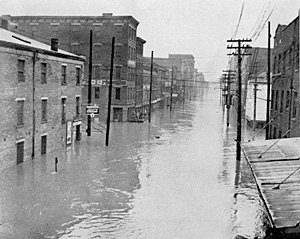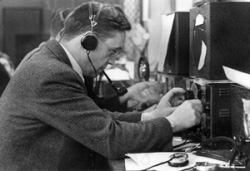By: Dawn Fuller
As Cincinnati marks the 75th year of the greatest flood to ravage this area, UC Archives reveal the university’s volunteer efforts and personal accounts in a university president’s diary.
“In the battle in which our city waged against the greatest flood in the history of the Ohio Valley, the University of Cincinnati has done its duty.” – UC President Raymond Walters, in a February 1937 letter to The News Record student newspaper.
The Great Flood of 1937 was never seen before in this area and has never been seen since. Record rains, followed by surging floodwaters, led to catastrophes that included fires and explosions on the Ohio River in Cincinnati and left behind massive destruction, power outages and, ironically, outages of clean, drinkable water. The local damage alone in 1937 was reported at $20 million ($300 million in current value). More than 50,000 people were reported to be homeless.
View “1937 Flood in Cincinnati – Historical Home Movie Footage”
The Ohio River’s flood level in Cincinnati is 52 feet. The river crested at nearly 80 feet on Jan. 26, 1937.
Geologically speaking, the flood was a larger natural disaster than Hurricane Katrina, according to UC Geology Professor Barry Maynard. “On average if you looked at several hundred years of records, this would be greater than the 100-year event, that is, it had a less than one-percent chance of happening,” Maynard explains. “Cincinnati’s current flood control structures are designed for an 80-feet height as a direct result of this flood.”
The University of Cincinnati’s role in this historic flood is stored in University Archives, in the minutes of the Board of Directors (now called the Board of Trustees), The News Record student newspaper, and the personal diaries of Raymond Walters, who served as UC president from 1932-1955.
UC President Raymond Walters’ Personal Reports
The archives report that the city (and the university) shut down from Jan. 23-Feb. 8.
On Jan. 22, 1937, UC President Raymond Walters turned to his diary after returning home from a snowstorm. The passage reads, “This has been a day of increasing damage, danger and nervous strain in the flooded areas of the Middle West. Radio broadcasts every hour at least and often at briefer intervals told the story of destruction and rescue. It is the highest flood in the history of the Ohio River.”
“Cincinnati is not to be under martial law, unless, as Mayor Wilson has just stated on the radio, ‘Something now unforeseen should occur,’” President Walters wrote in his diary on Jan. 25.
There were reports that nearly 70 percent of the city of Louisville was under water. “The misery of Louisville is pathetic,” President Walters wrote in his diary on Jan. 26, 1937. “Over 230,000 of its inhabitants, two-thirds of the entire population, are homeless. Having lived at Louisville for a short time during the war, I feel a special sense of sympathy for its soft-spoken citizens.” During World War I, Walters was captain of a field officers’ artillery school in Louisville.
On Jan. 30, Walters wrote that his entire family received typhoid shots at Holmes Hospital that afternoon, and that the river had dropped to 75 feet.
He wrote on Feb. 2 that the river had dropped to 66 feet, “but that I can assure you, still has menace in its swollen brown face.” President Walters also mentioned that the city was expected to have its power and water back by the end of that week. “I arranged today to hire glass containers for distilled water to be made available to the students in all our university buildings,” he wrote.
“To our extreme delight, water flowed from our faucets when we rose this morning,” Walters wrote on Feb. 3. “The city water department had made unexpectedly good progress in drying out the East End plant equipment.”
President Walters donated his diaries to UC Archives after he left office in 1955. He died in 1970.
A Special Obligation
“Members of the municipal university have a special obligation to foster and to practice good citizenship,” stated President Raymond Walters in his Feb. 16, 1937 memorandum to the UC Board of Directors. “To the record attained in times of peace and quiet is now added this manifestation of good citizenship in a time of peril and disorder. We are proud of the students, teachers, administrative officers and alumni of the university who volunteered promptly and who performed faithfully in the recent catastrophe.”
The Board of Directors minutes detailed five key areas where UC administrators, faculty, students and staff sprang into action to ease the great suffering of the Great Flood:
- University activities and Red Cross clothing assembly at Music Hall
- University short-wave radio station operated at our College of Engineering
- University ROTC unit serving in various duties throughout the stricken area
- College of Medicine service, with faculty and students administering many thousands of inoculations of relief workers with typhoid serum
- Work by university teachers and students at the Red Cross canteens and directly in the Red Cross organization
The Feb. 13, 1937 student newspaper, The News Record (free on newsstands now, but costing 3 cents in 1937) reported that nearly 1,500 UC students and faculty aided relief efforts.
Student Radio Station Aids the Effort
W8YX, UC’s student amateur radio club, is still in operation today and is now located in the Old Chemistry Building. Back in 1937, the radio station was located in Swift Hall.
A Feb. 17 News Record article written by Anna Quill reported that W8YX radio students, under the guidance of Engineering Professor William Osterbrock, received and sent emergency messages from the evening of Jan. 21 through midnight, Feb. 4. The report says the operators worked in “scantily heated rooms and had insufficient food supplies,” yet worked diligently to transmit messages for the Red Cross. The work included communicating assistance for a person from Indiana who was having an appendicitis attack.
The newspaper reported that a regular schedule was maintained with WLM in Washington, D.C., an army station. W8YX gave hourly river reports, requests for clothing, food and medical supplies and dispatching of police and fire department personnel from other towns in the flood district. “Orders for serum and vaccine could be communicated by amateur radio alone,” reported The News Record.
The radio station was credited with handling more than 2,000 messages – none of them personal.
The News Record report added that when the station’s electric power was threatened, the students prepared to stay up and running – with the help of a generator belted to a tractor provided by the International Harvester Company. “This never became necessary to use,” reported The News Record.
Other students in UC’s cooperative education program provided assistance at Music Hall and helped sandbag bridges and levies.
As UC got back in session, students planned a dance to help pay second semester tuition for students who were affected by the flood.
Also in the archives around the time of the flood was a mention that the UC Graduate School was celebrating its 30th anniversary. President Walters had requested from the Board of Directors an appropriation of $150 for the occasion.
UC Archives & Rare Books Library
Reprinted from UC News




